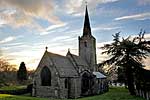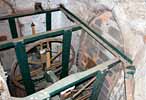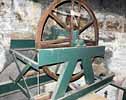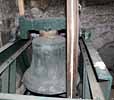 Sutton Bonington Sutton Bonington
St Michael
Bells
There are currently six bells in the tower of St Michael’s Church; however, there were originally only three. They were mounted in an oak frame, just below the present clock housing. They were rung from the ground floor and the rope guides can still be seen in the vestry ceiling. These bells were confiscated during the reign of Henry VIII but were handed back to the church on 6 August 1553. In 1849 the three bells were augmented to five with the addition of new treble and tenor bells. These were housed in a new two tier oak frame constructed around the clock, the work being undertaken by John Taylor & Son of Loughborough and paid for with funds raised by local subscriptions.
The Leicester Mercury of 23 June 1849 reports on a ringing competition held to inaugurate the new peal of five bells. Bands of ringers from South Normanton, Sileby, Rothley, Sheepshed (sic), Wymeswold and Attenborough competed throughout the day. The ringing was described as 'very indifferent, not more than two change-peels being rung by all the prize ringers, and none raising the bells without changing places.' The first prize of 50s was awarded to Attenborough and the second of 20 shillings to Rothley. 'The society of change-ringers arrived from Syston by the afternoon train, but by the rest of the competitors were considered too late to ring for the prizes'. However, they rang 'in an excellent manner, far surpassing any former ringers of the day. In the course of the evening two more cheering peals were rung in the steeple, and a course of cators on the hand-bells, two in hand, at the Boot Inn, by the same society, in equally good style, their ringing altogether showing them to be completely master of their work.'
By 1902 the oak frame had become very unsafe and so the bells were rehung, higher in the tower, in a new metal ‘H’ frame. This also gave sufficient space for them to be hung on one level, and also for ringing to be moved from the vestry to the present ringing room. The frame is of composite construction, comprising cast iron H section side frames that are machined on their bearing and base surfaces. These frame sides are bolted to a foundation of rolled steel girders that take a bearing in the tower walls at some nine points. The upper arms of the H are tied by an angle iron framework that itself takes a bearing in the tower walls via cast iron shoes. The work was paid for by Sir Ernest Paget.
By 1975 the plain bearings of the bells had become very worn and with local help and fund raising the headstocks were taken down, new ball bearings fitted and the frame and fittings restored. At the time it was recommended that a floor should be fitted over the bells to protect them from the elements, but this could not be afforded.
In 1977 the sixth bell was added to the peal to commemorate Queen Elizabeth II’s Silver Jubilee. This bell was installed in a metal frame, above the existing ‘H’ frame. All the work was carried out by local bell ringers.
The bell installation was overhauled and essential maintenance carried out in October 2009, faculty No 16629, by Hayward Mills Associates at a cost of £7,668 with help from local ringers. The money was raised by fund raising events and donations. Ingress of water had caused deterioration of the fixings. All ends were chopped out and rust removed before being coat with rust inhibiting paint and then re-concreted into the walls. The treble and 2nd bells were turned through 180 degrees to allow better access for the ropes. All pulleys and wheels were reconditioned and refitted into new positions where required. New rope holes were drilled and old rope holes covered with plywood and made good. The entire framework was scraped and wire brushed down then painted. A new metal RSJ was fitted on the top of the frame and an extension made to a secondary RSJ on the treble.
 Bellframe Bellframe |
 Bells Bells |
 Upper bellframe Upper bellframe |
 Treble bell Treble bell |
The faculty was granted subject to early consideration being given to the addition of a new floor in the base of the spire to reduce maintenance costs and improve access (as first recommended in 1975). This work was completed in November 2011, faculty No 17001. The work was done by local builders, Saunders Bros (Builders) Ltd of Main St, Sutton Bonington, at a cost of £1,800.
Treble Bell
30.5 inches (77cms) in diameter, weighing 4cwts 86lbs (242.2kg). This bell was purchased from St Andrew’s Church, Watton-at-Stone, Hertfordshire on 27th February 1977 for £320 which was raised in the village to commemorate Queen Elizabeth II’s Silver Jubilee. The work was completed in April 1977 by local ringers.
The inscription on the bell reads:
| T. KIMPTON J. ROWLEY C.W. J. BRIANT HARTFORD FECIT 1785 |
Second Bell
36 inches (901cms) in diameter 7cwts 49lbs (377.8kg). This is the original treble bell of the peal of five, installed in 1849.
The inscription on the bell reads:
JOHN TAYLOR & SON FOUNDERS LOUGHBOROUGH
THE YEAR OF OUR SALVATION 1849 |
On the waist is inscribed:
| GLORIA IN EXCELSIS DEO AMEN |
Third Bell
36.5 inches (92cms) 7cwts 2lbs (356.5kg). This was the second of the original bells to be recast and hung to celebrate Queen Elizabeth I’s Silver Jubilee but unfortunately, due to faults in the casting, this bell had to be recast in 1599 probably by Henry Oldfield 2nd, master founder 1590-1620 at the Oldfield Foundry of Long Row, Nottingham.
The inscription on the bell at that time read:
GOD SAVE THE CHURCH OVR QVEEN AND REALM
AND SEND VS PEACE IN CHRIST AMEN 1599 |
with the Royal Coat of Arms adjacent.
This bell was rehung as the second bell of the peal of five in 1849. It later proved to be cracked and was recast in 1850 by John Taylor & Son.
The inscription on the bell now reads:
| E. DALBY J. WILKINSON I. WILKINSON |
On the waist is inscribed:
| I TAYLOR AND SON FOUNDERS LOUGHBOROUGH AD 1850 |
Fourth Bell
37.75 inches (96cms) 8cwts 65lbs (435.kg). The last of the original bells to be recast, possibly by Henry Oldfield 2nd. It is known as the ARMADA BELL and is dedicated to Queen Elizabeth I.
The inscription on the bell reads:
| GOD SAVE OVR QVEEN HO 1602 |
Fifth Bell
42.5 inches (107cms) 11cwts 44lbs (578.8kg). This is the oldest bell in the tower and was the first of the original bells to be recast in 1579 by Henry Oldfield 1st who started the foundry and was casting bells from around 1540 until his death in 1590.
The inscription on the bell reads:
FOSTIN FEILDING ESQ MVXW HENRY STANLEY GEN THOMAS THOMSON PR HO
1579
RAFE BVNINGTON GEN MICHAEL HASLERIG GEN HM YT SY |
Tenor Bell
49.5 inches (125cms) 17cwts 97lbs (907.6kg) E flat. This bell was cast by John Taylor & Son and added to the ring of three bells with the present second bell (then the treble) in 1849, bringing the peal to five bells.
The inscription on the bell reads:
ISRAEL HOPKINS ESQ
THE TREBLE AND TENOR WERE RAISED BY SUBSCRIPTION AD 1849 |
|